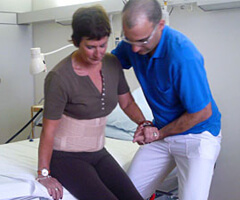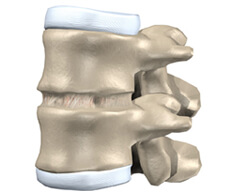Inter Body Fusion
A wide variety of techniques exist to fuse lumbar spine vertebrae to eliminate or diminish back pain, including posterior, transforaminal, anterior, and lateral lumbar interbody fusion (PLIF, TLIF, ALIF, and LLIF, respectively).
Anterior Lumbar Interbody Fusion (ALIF)
This is performed to remove the portion of degenerated disc that is the source of pain. The procedure involves creating room between the vertebral bodies, relieving pressure and creating more space for spinal nerves to exit. It is named so because the spine is approached from the front. This approach avoids damage to the low back muscles. The removed portion is replaced with bone graft material, and adjacent vertebral bodies are fused to provide support.
 A majority of patients suffering from low back pain do not need surgery to treat their condition. However, sometimes surgery alone can help when all other methods fail. But no one type of surgery is right for the treatment of every low back pain problem. Spinal fusion has been used for years to treat painful conditions in the lower spine. Designed to stabilize and hold the bones together while the fusion heals, these devices have greatly improved the success rate of fusion in the lower back.
A majority of patients suffering from low back pain do not need surgery to treat their condition. However, sometimes surgery alone can help when all other methods fail. But no one type of surgery is right for the treatment of every low back pain problem. Spinal fusion has been used for years to treat painful conditions in the lower spine. Designed to stabilize and hold the bones together while the fusion heals, these devices have greatly improved the success rate of fusion in the lower back.
One of the primary objectives of a surgery on the skeletal system is to eliminate the pain caused by joints, whatever their reason may be. A reliable way to reduce degeneration pain of any joint is to fuse them together. A fusion is a procedure where two bones, usually separated by a joint, are allowed to grow together or fuse into one bone, and is true for the spine as well. An anterior approach enables the surgeon to remove the intervertebral disc from the front and place bone graft between the vertebrae. This type of operation is usually performed by making an incision in the abdomen, just above the pelvic bone. The organs in the abdomen are moved to the side, allowing the surgeon to see the front of the spine. The surgeon then determines which intervertebral disc is the damaged one and removes it. Bone graft is then placed into the area between the vertebrae where the disc has been removed. Implants are being used to spread the two vertebrae and hold them apart while the fusion heals.

Planning your medical trip to India is a very simple process with Spine and Neuro Surgery Hospital India
- You just need to fill in our enquiry form and one of our executive will contact you soon.
- +91-9325887033 Call us at the given to contact number for any assistance.
- Complete information regarding surgery is provided on our website.
Posterior Lumbar Interbody Fusion (PLIF)
A posterior lumbar interbody fusion (PLIF) removes a disc that is the cause of back or leg pain and fuses spinal vertebrae with bone grafts. It is called posterior procedure because the spine is approached through an incision on the back. The posterior approach is undertaken from the back of the patient. It can either just fuse the vertebral bones or remove the problem disc. The removed disc is replaced with a bone graft. In this approach, an incision is made in the middle of the lower back over the area of the spine that is going to be fused. The muscles are moved to the side so that the surgeon can view the backside of the vertebrae.
When the spine can be seen, the lamina of the vertebra is removed to take pressure off the dura and nerve roots. This allows the surgeon to see areas of pressure on the nerve roots caused by bone spurs, a bulging disc, or thickening of the ligaments. These structures can be removed or trimmed to relieve the pressure on the nerves. When operating from the posterior, the most preferred method is to place the bone graft around the back side of the vertebrae. The surgeon likely uses some type of metal screws, plates, and rods to hold the vertebrae in place while the spine fusion heals. Special screws called pedicle screws are inserted into the vertebral body. These screws are placed down the small bony tube created by the pedicle on each side of the vertebra, between the nerve roots. This allows the screws to grab into the bone of the vertebral body, giving them a good solid hold on the vertebra. Once these screws are placed, one in each pedicle, they are attached to metal rods that connect all the screws together. Once everything is fused and tightened, this creates a stiff metal frame that is intended to hold the vertebrae still so that healing can occur. Bone graft is then placed around the back of the vertebrae.
In patients with spinal instability, instrumentation is used to provide space for placing the grafts and to help stabilize the spine. Using a technique known as minimally invasive surgery, posterior lumbar interbody fusion can be done with a much smaller incision than traditional open spinal surgeries and avoids damaging the low back muscles.
Transforaminal Lumbar Interbody Fusion (TLIF)
As in the posterior lumbar interbody fusion (PLIF) technique, a bone graft is used to fuse the spinal vertebrae after the disc is removed. However, the TLIF procedure places a single bone graft between the vertebrae from the side, rather than two bone grafts from the rear, as in the PLIF procedure. Inserting the graft from the side where the facet joint has been removed avoids moving or damaging nerve roots during the procedure.
Minimally Invasive TLIF
For patients suffering from spinal instability, instrumentation is needed to help stabilize the spine during the bone graft fusion. Using minimally invasive surgery, transforaminal lumbar interbody fusion can be done in certain patients with a much smaller incision than traditional open spinal surgeries, decreasing damage to the low back muscles.
Lateral Lumbar Interbody Fusion (LLIF)
 LLIF procedure, also referred to as lateral access spine surgery, is a minimally invasive procedure that accesses the spine from incisions on the side of the body. This procedure avoids separating the low back muscles, cutting bone, or moving aside blood vessels as required for other minimally invasive spine fusion procedures. Lateral access spine surgery can treat a wide variety of spinal conditions including disc herniations, asymmetric disc degeneration (degenerative scoliosis), certain tumors, nerve impingement, and instability and pain resulting from disc degeneration. Associated complications
LLIF procedure, also referred to as lateral access spine surgery, is a minimally invasive procedure that accesses the spine from incisions on the side of the body. This procedure avoids separating the low back muscles, cutting bone, or moving aside blood vessels as required for other minimally invasive spine fusion procedures. Lateral access spine surgery can treat a wide variety of spinal conditions including disc herniations, asymmetric disc degeneration (degenerative scoliosis), certain tumors, nerve impingement, and instability and pain resulting from disc degeneration. Associated complications
Complications with Interbody fusion
With any surgery comes the risk of complications. When a surgery is done near the spine and spinal cord, these complications can be very serious. They could involve subsequent pain and impairment and the need for additional surgery. The patient should discuss the complications associated with any form of surgery with the doctor beforehand. The list of complications provided on websites may not be a complete list of complications and should not be considered a substitute for discussing the risks of surgery with the doctor. Only an expert can evaluate the condition and inform of the risks of any medical treatment he or she may recommend.
Related Pages
Want to have a FREE Consultation for your Inter Body Fusion Surgery in India?
We will give you best surgeons for taking best and safe treatments at an affordable low cost. Post a query and get a quick response
Click Here